【TPO 小站】托福阅读真题背景总汇
- 格式:doc
- 大小:30.50 KB
- 文档页数:3
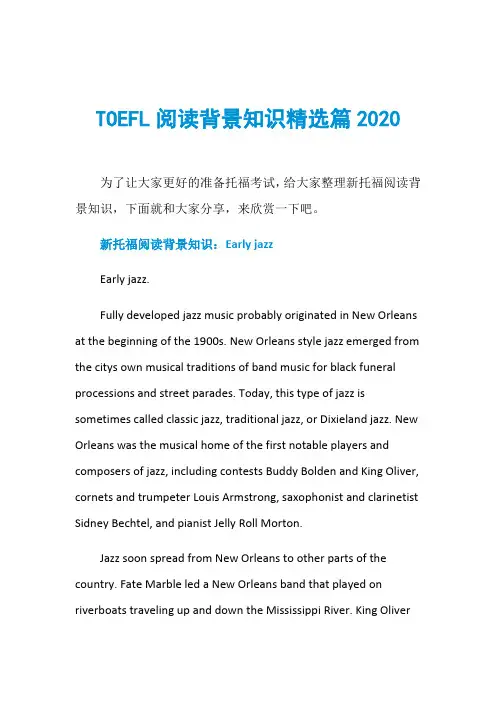
TOEFL阅读背景知识精选篇2020为了让大家更好的准备托福考试,给大家整理新托福阅读背景知识,下面就和大家分享,来欣赏一下吧。
新托福阅读背景知识:Early jazzEarly jazz.Fully developed jazz music probably originated in New Orleans at the beginning of the 1900s. New Orleans style jazz emerged from the citys own musical traditions of band music for black funeral processions and street parades. Today, this type of jazz is sometimes called classic jazz, traditional jazz, or Dixieland jazz. New Orleans was the musical home of the first notable players and composers of jazz, including contests Buddy Bolden and King Oliver, cornets and trumpeter Louis Armstrong, saxophonist and clarinetist Sidney Bechtel, and pianist Jelly Roll Morton.Jazz soon spread from New Orleans to other parts of the country. Fate Marble led a New Orleans band that played on riverboats traveling up and down the Mississippi River. King Olivermigrated to Chicago, and Jelly Roll Morton performed throughout the United States. Five white musicians formed a band in New Orleans, played in Chicago, and traveled to New York City, calling them the Original Dixieland Jazz Band (the spelling was soon changed to "Jazz"). This group made the earliest jazz phonograph recordings in 1917. Mamie Smith recorded "Crazy Blues" in 1920, and recordings of ragtime, blues, and jazz of various kinds soon popularized the music to a large and eager public.The 1920sThe 1920s have been called the golden age of jazz or the jazz age. Commercial radio stations, which first appeared in the 1920s, featured live performances by the growing number of jazz musicians. New Orleans; Memphis; St. Louis; Kansas City, Missouri; Chicago; Detroit; and New York City were all important centers of jazz.A group of Midwest youths, many from Chicagos Austin High School, developed a type of improvisation and arrangement that became known as "Chicago style" jazz. These musicians included trumpeters Jimmy McFarland and Muggy Spinier; cornets Box Beiderbecke; clarinetists Frank Tastemaker, Pee Wee Russell, Mezzo, and Benny Goodman; saxophonists Frankie Rombauer andBud Freeman; drummers Dave Tough, George Wetting, and Gene Krupp; and guitarist Eddie Condon. They played harmonically inventive music, and the technical ability of some of the players, especially Goodman, was at a higher level than that of many earlier performers.In New York City, James P. Johnson popularized a new musical style from ragtime called stride piano. In stride piano, the left hand plays alternating single notes and chords that move up and down the scale while the right hand plays solo melodies, accompanying rhythms, and interesting choral passages. Johnson strongly influenced other jazz pianists, notably Count Basie, Duke Ellington, Art Tatum, Fats Waller, and Teddy Wilson.Fletcher Henderson was the first major figure in big band jazz. In 1923, he became the first leader to organize a jazz band into sections of brass, reed, and rhythm instruments. His arranger, Don Redman, was the first to master the technique of scoring music for big bands. Various Henderson bands of the 1920s and 1930s included such great jazz instrumentalists as Louis Armstrong and saxophonists Benny Carter and Coleman Hawkins.Armstrong made some of his most famous recordings with his own Hot Five and Hot Seven combos from 1925 to 1928. Theserecordings rank among the masterpieces of jazz, along with his duo recordings of the same period with pianist Earl "Fatah" Hines. Armstrong also became the first well-known male jazz singer, and popularized scat singing-that is, wordless syllables sung in an instrumental manner.During the late 1920s and early 1930s, jazz advanced from relatively simple music played by performers who often could not read music to a more complex and sophisticated form. Among the musicians who brought about this change were saxophonists Benny Carter, Coleman Hawkins, and Johnny Hodges; the team of violinist Joe Venetia and guitarist Eddie Lang; and pianist Art Tatum. Many people consider Tatum the most inspired and technically gifted improviser in jazz history.The swing era flourished from the mid-1930s to the mid-1940. In 1932, Duke Ellington recorded his composition "It Dont Mean a Thing If It Isn’t Got That Swing." "Swing" was soon adopted as the name of the newest style of jazz. Swing emphasizes four beats to the bar. Big bands dominated the swing era, especially those of Count Basie, Benny Goodman, and Duke Ellington.Benny Goodman became known as the "King of Swing." Starting in 1934, Goodmans bands and combos brought swing tonationwide audiences through ballroom performances, recordings, and radio broadcasts. Goodman was the first white bandleader to feature black and white musicians playing together in public performances. In 1936, he introduced two great blacksoloists-pianist Teddy Wilson and vibraphonist Lionel Hampton. Until then, racial segregation had held back the progress of jazz and of black musicians in particular. In 1938, Goodman and his band, and several guest musicians, performed a famous concert at Carnegie Hall in New York City. Their performance was one of the first by jazz musicians in a concert hall setting.Other major bands of the swing era included those led by Benny Carter, Bob Crosby, Jimmy Dorsey, Tommy Dorsey, Woody Herman, Earl Hines, Andy Kirk, Jimmie Lunsford, Glenn Miller, Artie Shaw, Chick Webb, and, toward the end of the period, Stan Kenton. The bands in Kansas City, Missouri, especially the Count Basie band, had a distinctive swing style. These bands relied on the 12-bar blues form and riff backgrounds, which consisted of repeated simple melodies. They depended less heavily on written arrangements, allowing more leeway for rhythmic drive and for extended solo improvisations.新托福阅读背景知识:Boogie-woogie。
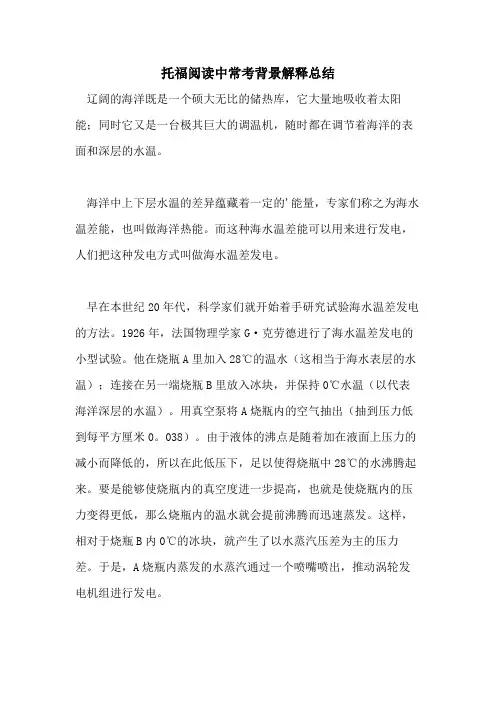
托福阅读中常考背景解释总结辽阔的海洋既是一个硕大无比的储热库,它大量地吸收着太阳能;同时它又是一台极其巨大的调温机,随时都在调节着海洋的表面和深层的水温。
海洋中上下层水温的差异蕴藏着一定的'能量,专家们称之为海水温差能,也叫做海洋热能。
而这种海水温差能可以用来进行发电,人们把这种发电方式叫做海水温差发电。
早在本世纪20年代,科学家们就开始着手研究试验海水温差发电的方法。
1926年,法国物理学家G·克劳德进行了海水温差发电的小型试验。
他在烧瓶A里加入28℃的温水(这相当于海水表层的水温);连接在另一端烧瓶B里放入冰块,并保持0℃水温(以代表海洋深层的水温)。
用真空泵将A烧瓶内的空气抽出(抽到压力低到每平方厘米0。
038)。
由于液体的沸点是随着加在液面上压力的减小而降低的,所以在此低压下,足以使得烧瓶中28℃的水沸腾起来。
要是能够使烧瓶内的真空度进一步提高,也就是使烧瓶内的压力变得更低,那么烧瓶内的温水就会提前沸腾而迅速蒸发。
这样,相对于烧瓶B内0℃的冰块,就产生了以水蒸汽压差为主的压力差。
于是,A烧瓶内蒸发的水蒸汽通过一个喷嘴喷出,推动涡轮发电机组进行发电。
克劳德试验成功以后,于1929年在古巴建造了一套专门进行海水温差发电的实验装置。
他用一根直径2米的铜管,在距离海岸2000米处,从 650米的深海中汲取冷海水。
当温海水的温度为27。
5℃而冷海水的温度为13℃时,其发电功率为22千瓦。
然而,他用水泵抽取冷海水时所消耗的功率却达 80千瓦。
这岂不是得不偿失吗?实际上不然,克劳德的这套实验装置的发电潜力并没有得到充分发挥,按计算其发电功率可达220千瓦。
但不管怎样,克劳德的实验表明:利用海水的温差来进行发电,在技术上是可行的。
现在的新型海水温差发电装置,是首先把海水引入太阳能加温池,将海水加温到45~60℃(有的可高达90℃),然后再将温海水引进保持真空的某一空间,让它蒸发,借助于水蒸汽来推动汽轮发电机组进行发电。
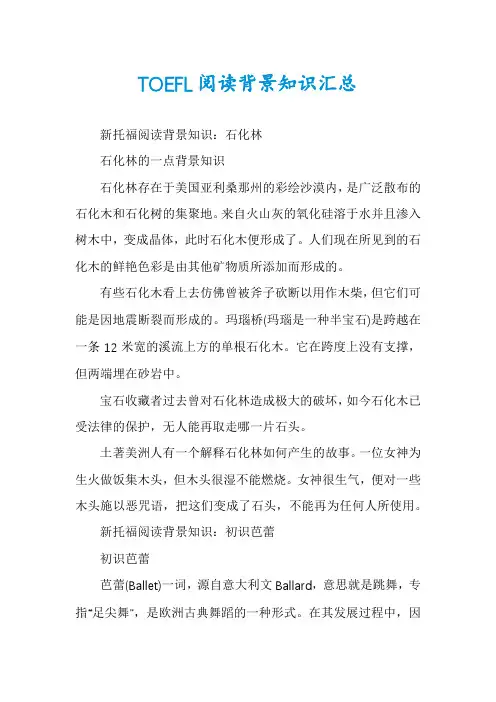
TOEFL阅读背景知识汇总新托福阅读背景知识:石化林石化林的一点背景知识石化林存在于美国亚利桑那州的彩绘沙漠内,是广泛散布的石化木和石化树的集聚地。
来自火山灰的氧化硅溶于水并且渗入树木中,变成晶体,此时石化木便形成了。
人们现在所见到的石化木的鲜艳色彩是由其他矿物质所添加而形成的。
有些石化木看上去仿佛曾被斧子砍断以用作木柴,但它们可能是因地震断裂而形成的。
玛瑙桥(玛瑙是一种半宝石)是跨越在一条12米宽的溪流上方的单根石化木。
它在跨度上没有支撑,但两端埋在砂岩中。
宝石收藏者过去曾对石化林造成极大的破坏,如今石化木已受法律的保护,无人能再取走哪一片石头。
土著美洲人有一个解释石化林如何产生的故事。
一位女神为生火做饭集木头,但木头很湿不能燃烧。
女神很生气,便对一些木头施以恶咒语,把这们变成了石头,不能再为任何人所使用。
新托福阅读背景知识:初识芭蕾初识芭蕾芭蕾(Ballet)一词,源自意大利文Ballard,意思就是跳舞,专指“足尖舞”,是欧洲古典舞蹈的一种形式。
在其发展过程中,因常以这种舞蹈来叙述表演故事,而逐渐形成了一种特殊的演出形式。
1772年,查理·狄德罗(Charles Diderot)在法国大百科全书中说:“芭蕾系用跳舞解释行动。
特别要求剧场性的赏心悦目。
”。
帕鲁金尼(Perugino)更详细地叙述说:“芭蕾是由一位编导,运用连带哑剧的一系列独舞和群众,附加音乐和布景,去表现一种诗情画意,或一连串概念,或一个故事化的情节。
”芭蕾这种舞蹈形式一直发展到今天,形成了完整的舞剧艺术。
对于中国观众来说,芭蕾并不陌生,尤其近些年来,芭蕾受到了越来越多的观注,一股“芭蕾热”已经在几座大城市悄然兴起。
1997年的“中国歌剧舞剧年”可以说是热闹非凡,各个中外演出团体为广大观众献上了一台又一台精彩的演出,真是“你方唱罢我登场”。
从通俗的《天鹅湖》到浪漫的《吉赛尔》,从“拉丁味”的《堂·吉诃德》到充满海新托福阅读背景知识:脚尖的艺术脚尖的艺术从运动的实际需要来看,脚尖鞋的发明能够将舞者身体的重量支撑“面”经过若干倍的缩小后变成支撑“点”,从而有效地减小与地面的摩擦力,提高旋转的速度,造成风驰电掣的效果、超凡脱俗的幻觉,进而更好地为仙凡之恋这类虚幻的芭蕾题材服务。
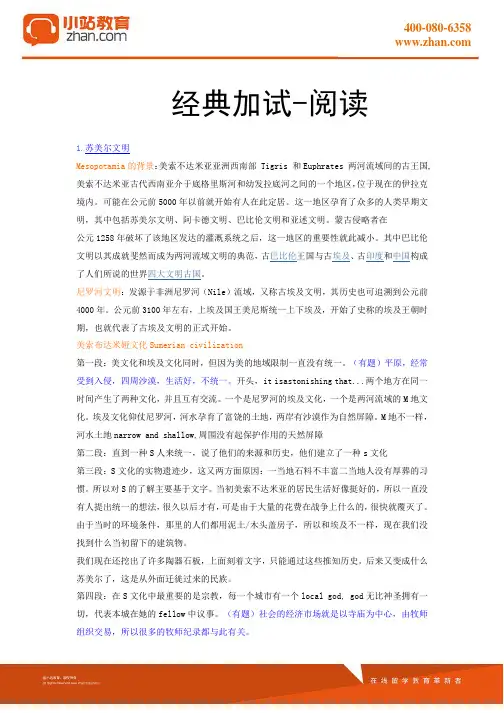
经典加试-阅读1.苏美尔文明Mesopotamia的背景:美索不达米亚亚洲西南部 Tigris 和Euphrates 两河流域间的古王国,美索不达米亚古代西南亚介于底格里斯河和幼发拉底河之间的一个地区,位于现在的伊拉克境内。
可能在公元前5000年以前就开始有人在此定居。
这一地区孕育了众多的人类早期文明,其中包括苏美尔文明、阿卡德文明、巴比伦文明和亚述文明。
蒙古侵略者在公元1258年破坏了该地区发达的灌溉系统之后,这一地区的重要性就此减小。
其中巴比伦文明以其成就斐然而成为两河流域文明的典范,古巴比伦王国与古埃及、古印度和中国构成了人们所说的世界四大文明古国。
尼罗河文明:发源于非洲尼罗河(Nile)流域,又称古埃及文明,其历史也可追溯到公元前4000年。
公元前3100年左右,上埃及国王美尼斯统一上下埃及,开始了史称的埃及王朝时期,也就代表了古埃及文明的正式开始。
美索布达米娅文化Sumerian civilization第一段:美文化和埃及文化同时,但因为美的地域限制一直没有统一。
(有题)平原,经常受到入侵,四周沙漠,生活好,不统一。
开头,it isastonishing that...两个地方在同一时间产生了两种文化,并且互有交流。
一个是尼罗河的埃及文化,一个是两河流域的M地文化。
埃及文化仰仗尼罗河,河水孕育了富饶的土地,两岸有沙漠作为自然屏障。
M地不一样,河水土地narrow and shallow,周围没有起保护作用的天然屏障第二段:直到一种S人来统一,说了他们的来源和历史,他们建立了一种s文化第三段:S文化的实物遗迹少,这又两方面原因:一当地石料不丰富二当地人没有厚葬的习惯。
所以对S的了解主要基于文字。
当初美索不达米亚的居民生活好像挺好的,所以一直没有人提出统一的想法,很久以后才有,可是由于大量的花费在战争上什么的,很快就覆灭了。
由于当时的环境条件,那里的人们都用泥土/木头盖房子,所以和埃及不一样,现在我们没找到什么当初留下的建筑物。
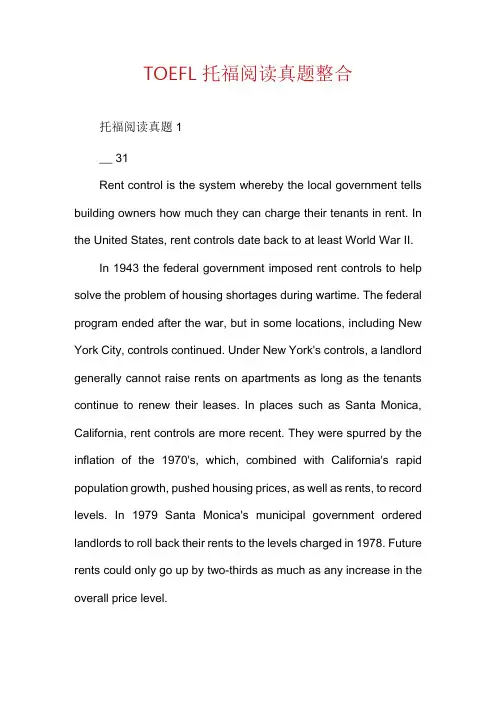
TOEFL托福阅读真题整合托福阅读真题1__ 31Rent control is the system whereby the local government tells building owners how much they can charge their tenants in rent. In the United States, rent controls date back to at least World War II.In 1943 the federal government imposed rent controls to help solve the problem of housing shortages during wartime. The federal program ended after the war, but in some locations, including New York City, controls continued. Under New York's controls, a landlord generally cannot raise rents on apartments as long as the tenants continue to renew their leases. In places such as Santa Monica, California, rent controls are more recent. They were spurred by the inflation of the 1970's, which, combined with California's rapid population growth, pushed housing prices, as well as rents, to record levels. In 1979 Santa Monica's municipal government ordered landlords to roll back their rents to the levels charged in 1978. Future rents could only go up by two-thirds as much as any increase in the overall price level.In any housing market, rental prices perform three functions: (1) promoting the efficient maintenance of existing housing and stimulating the construction of new housing, (2) allocating existing scarce housing among competing claimants, and (3) rationing use of existing housing by potential renters.One result of rent control is a decrease in the construction of new rental units. Rent controls have artificially depressed the most important long-term determinant of profitability —rents. Consider some examples. In a recent year in Dallas, Texas, with a 16 percent rental vacancy rate but no rent control laws, 11,000 new housing units were built. In the same year, in San Francisco, California, only 2,000 units were built. The major difference? San Francisco has only a 1.6 percent vacancy rate but stringent rent control laws. In New York City, except for government-subsidized construction, the only rental units being built are luxury units, which are exempt from controls. In Santa Monica, California, new apartments are not being constructed. New office rental space and commercial developments are, however. They are exempt from rent controls.1. What does the passage mainly discuss?(A) The construction of apartments in the United States.(B) Causes and effects of rent control(C) The fluctuations of rental prices(D) The shortage of affordable housing in the United States.2. The word They in line 9 refers to(A) the tenants(B) their leases(C) places(D) rent controls.3. Which of the following was NOT a reason for the introduction of rent controls in Santa Monica,California?(A) rapid population growth(B) inflation(C) economic conditions during wartime(D) record-high housing prices4. The phrase roll back in line 11 is closest in meaning to(A) credit(B) measure(C) vary(D) reduce5. The word stimulating in line 15 is closest in meaning to(A) experimenting with(B) identifying(C) estimating(D) encouraging6. It can be inferred that the purpose of rent control is to(A) protect tenants(B) promote construction(C) increase vacancy rates(D) decrease sales of rental units7. The word depressed in line 19 is closest in meaning to(A) saddened(B) created(C) lowered(D) defeated8. The information in the last paragraph supports which of the following statements?(A) San Francisco has eliminated its rent control laws.(B) Rent control leads to a reduction in the construction of housing units(C) Luxury apartments are rarely built when there is rent control(D) There is a growing need for government-subsidized housing.9. According to the passage , which of the following cities does NOT currently have rent controls?(A) Santa Monica(B) Dallas(C) San Francisco(D) New York City10. The word stringent in line 23 is closest in meaning to(A) straightforward(B) strict(C) expanded(D) efficient11. According to the passage , which of the following is NOT exempt from rent control?(A) Luxury apartments(B) Commercial development(C) Moderately priced apartments(D) Office space.__ 31 BDCDD ACBBB C托福阅读真题232By 1776 the fine art of painting as it had developed in western Europe up to this time had been introduced into the American colonies through books and prints, European visitors andimmigrants, and traveling colonists who brought back copies (and a few original) of old master paintings and acquaintance with European art institutions.By the outbreak of the Revolution against British rule in 1776, the status of the artists had already undergone change. In the mid-eighteenth century, painters had been willing to assume such artisan-related tasks as varnishing, gilding teaching, keeping shops, and painting wheel carriages, houses, and signs. The terminology by which artists were described at the time suggests their status: limner was usually applied to the anonymous portrait painter up to the 1760's; painter characterized anyone who could paint a flat surface. By the second half of the century, colonial artists who were trained in England or educated in the classics rejected the status of laborer and thought of themselves as artists. Some colonial urban portraitists, such as John Singleton Copley, Benjamin West, and Charles Wilson Peale, consorted with affluent patrons. Although subject to fluctuations in their economic status, all three enjoyed sufficient patronage to allow them to maintain an image of themselves as professional artists, an image indicated by their custom of signing their paintings. A few art collectors James Bowdoin III of Boston, William Byrd of Virginian, and the Aliens andHamiltons of Philadelphia introduced European art traditions to those colonists privileged to visit their galleries, especially aspiring artists, and established in their respective communities the idea of the value of art and the need for institutions devoted to its encouragement.Although the colonists tended to favor portraits, they also accepted landscapes, historical works, and political engravings as appropriate artistic subjects. With the coming of independence from the British Crown, a sufficient number of artists and their works were available to serve nationalistic purposes. The achievements of the colonial artists, particularly those of Copley, West, and Peale, lent credence to the boast that the new nation was capable of encouraging genius and that political liberty was congenial to the development of taste — a necessary step before art could assume an important role in the new republic.1. What does the passage mainly discuss?(A) European influence on colonial American painting(B) The importance of patronage to artist(C) The changing status of artists in the American colonies in the eighteenth century(D) Subjects preferred by artists in the American colonies in theeighteenth century.2. The word outbreak in line 5 is closest in meaning to(A) cause(B) beginning(C) position(D) explanation3. The word undergone in line 6 is closest in meaning to(A) led to(B) transformed(C) preferred(D) experienced4. According to the passage , before the American Revolution the main task of limners was to(A) paint wheel carriages(B) paint portraits(C) varnish furniture(D) paint flat surfaces5. I t can be inferred from the passage that artists who were trained in England(A) considered artists to be superior to painters(B) barely painted portraitists(C) were often very wealthy(D) imitated English painters6. The word consorted in line 14 is closest in meaning to(A) made decisions(B) studies(C) agreed(D) associated7. The word sufficient in line 16 is closest in meaning to(A) adequate(B) temporary(C) friendly(D) expensive8. According to the passage , artists such as Copley, West and Peal signed their paintings(A) increased the monetary value of the paintings(B) made it more difficult for other artists to copy the paintings(C) supported the artists' image of professionalism(D) distinguished colonial American artists from European artists9. The author mentions James Bowdoin III and William Byrd in line 17 as examples of which ofthe following?(A) Art gallery owners who displayed only European art(B) Art collectors who had a profound influence on American attitudes toward art(C) Artists who gave financial support to other artists(D) Patrons whose helped to encourage artisans to become artists10. With which of the following would the author be most likely to agree?(A) Countries that have not had a political revolution are unlikely to develop great art.(B) The most successful art collectors are usually artists themselves.(C) The value of colonial American paintings decreased after the Revolution.(D) Colonial artists made an important contribution to the evolving culture of the new nation.__ 32 CBDBA DACBD托福阅读真题3__ 33Researchers in the field of psychology have found that one of the best ways to make an important decision, such as choosing auniversity to attend or a business to invest in, involves the utilization of a decision worksheet. Psychologists who study optimization compare the actual decisions made by people to theoretical ideal decisions to see how similar they are. Proponents of the worksheet procedure believe that it will yield optimal, that is, the best decisions. Although there are several variations on the exact format that worksheets can take, they are all similar in their essential aspects. Worksheets require defining the problem in a clear and concise way and then listing all possible solutions to the problem. Next, the pertinent considerations that will be affected by each decision are listed, and the relative importance of each consideration or consequence is determined. Each consideration is assigned a numerical value to reflect its relative importance. A decision is mathematically calculated by adding these values together. The alternative with the highest number of points emerges as the best decision.Since most important problems are multifaceted, there are several alternatives to choose from, each with unique advantages and disadvantages. One of the benefits of a pencil and paper decision-making procedure is that it permits people to deal with more variables than their minds can generally comprehend and remember.On the average, people can keep about seven ideas in their minds at once. A worksheet can be especially useful when the decision involves a large number of variables with complex relationships. A realistic example for many college students is the question What will I do after graduation? A graduate might seek a position that offers specialized training, pursue an advanced degree, or travel abroad for a year.A decision-making worksheet begins with a succinct statement of the problem that will also help to narrow it. It is important to be clear about the distinction between long-range and immediate goals because long-range goals often involve a different decision than short-range ones. Focusing on long- range goals, a graduating student might revise the question above to What will I do after graduation that will lead to successful career?1. What does the passage mainly discuss?(A) A tool to assist in making complex decisions.(B) A comparison of actual decisions and ideal decisions(C) Research on how people make decisions(D) Differences between long-range and short-range decision making2. The word essential in line 7 is closest in meaning to(A) introductory(B) changeable(C) beneficial(D) fundamental3. The word pertinent in line 9 is closest in meaning to(A) relevant(B) preceding(C) insightful(D) responsive4. Of the following steps, which occurs before the others in making a decision worksheet?(A) Listing the consequences of each solution(B) Calculating a numerical summary of each solution(C) Deciding which consequences are most important(D) Writing down all possible solutions5. According to decision-worksheet theory, an optimal decision is defined as one that(A) has the fewest variables to consider(B) uses the most decision worksheets(C) has the most points assigned to it(D) is agreed to by the greatest number of people6. The author develops the discussion in paragraph 1 bymeans of(A) describing a process(B) classifying types of worksheets(C) providing historical background(D) explaining a theory7. The author states that On the average, people can keep about seven ideas in their minds atonce (lines 17-18) to explain that(A) most decisions involve seven steps(B) human mental capacity has limitations(C) some people have difficulty making minor as well as major decisions(D) people can learn to keep more than seven ideas in their minds with practice8. The word succinct in line 24 is closest in meaning to(A) creative(B) satisfactory(C) personal(D) concise9. Which of the following terms is defined in the passage(A) Proponents (line 5)(B) Optimal (line 5)(C) Variables (line 17)(D) Long-range goals (line 25)10. The word it in line 24 refers to(A) worksheet(B) problem(C) distinction(D) decision11. The word revise in line 26 is closest in meaning to。

TOEFL新托福阅读背景知识精选5篇新托福阅读背景知识:太空城休士顿太空城休士顿休士顿是美国的第五大都市,人类第一次登上月球的阿波罗飞船11号就在这里升空,因而使它也成为全球闻名的城镇。
这一城镇是在1836年当德克萨斯州自墨西哥获得独立时,随之而诞生。
通往墨西哥湾的休士顿港,是美国第三大港,在那里出口的棉花和石油产品,其数量占全美第一位。
自从美国国家航空太空总署NASA在近效设置太空中心以来,休士顿正在继续不断地急速发展。
阿斯托洛圆顶运动场Astrodome耗资3,100万美元,于1965年兴建完成的这一运动场是目前世界上最大的一座室内运动场,内部装有冷暖气设备。
棒球、足球、骞马,以至于马戏团表演,都可以在室内进行。
紧邻的Afterworld是一个规模极大的娱乐中心,游客可以观赏欧洲各种村落的景色,也能够欣赏各类表演。
圣哈新托古战场SanJacintoBattlefield1836年,休士顿将军为了争取德州独立,率军与墨军激战的地方。
现在已成为州立公园,纪念塔高达174公尺,可乘电梯登上塔项。
塔下是历史博物馆。
距休士顿市约26公里。
美国航空太空总署太空飞行中心NASAMannedSpacecraft因阿波罗11号在此升空而全球闻名。
美国国家航空太空总署NASA于1961年设立于休士顿东南方45公里处的克利阿湖畔。
附近有GeneralElectric和InternationalBusinessMachines等重要的电子工业企业,是名符其实的航空太空科学中心。
展览馆Exhibit Hall的一号馆中,陈列着太空飞行员使用的器具、太空食物、太空船模型、月球上采集的岩石,对一般观光客公开。
太空飞行中心内部极为辽阔,可在进入中心的问讯处索取地图,备作参考。
太空中心内也有礼品店,出售太空船模型、月球石头模型,以及阿波罗帽等。
新托福阅读背景知识:友爱之城费城费城费城是美国第四大都市,随同岁月的飞逝,与工业化的进展,费城所拥有的历史性遗产,已逐渐褪色。
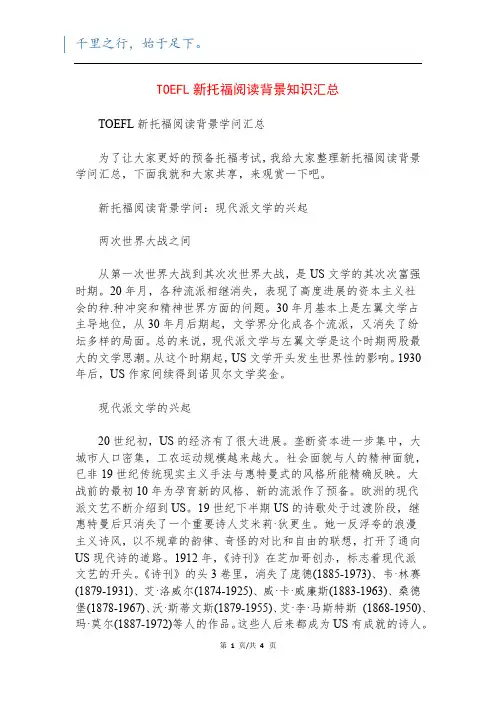
TOEFL新托福阅读背景知识汇总TOEFL新托福阅读背景学问汇总为了让大家更好的预备托福考试,我给大家整理新托福阅读背景学问汇总,下面我就和大家共享,来观赏一下吧。
新托福阅读背景学问:现代派文学的兴起两次世界大战之间从第一次世界大战到其次次世界大战,是US文学的其次次富强时期。
20年月,各种流派相继消失,表现了高度进展的资本主义社会的种.种冲突和精神世界方面的问题。
30年月基本上是左翼文学占主导地位,从30年月后期起,文学界分化成各个流派,又消失了纷坛多样的局面。
总的来说,现代派文学与左翼文学是这个时期两股最大的文学思潮。
从这个时期起,US文学开头发生世界性的影响。
1930年后,US作家间续得到诺贝尔文学奖金。
现代派文学的兴起20世纪初,US的经济有了很大进展。
垄断资本进一步集中,大城市人口密集,工农运动规模越来越大。
社会面貌与人的精神面貌,已非19世纪传统现实主义手法与惠特曼式的风格所能精确反映。
大战前的最初10年为孕育新的风格、新的流派作了预备。
欧洲的现代派文艺不断介绍到US。
19世纪下半期US的诗歌处于过渡阶段,继惠特曼后只消失了一个重要诗人艾米莉·狄更生。
她一反浮夸的浪漫主义诗风,以不规章的韵律、奇怪的对比和自由的联想,打开了通向US现代诗的道路。
1912年,《诗刊》在芝加哥创办,标志着现代派文艺的开头。
《诗刊》的头3卷里,消失了庞德(1885-1973)、韦·林赛(1879-1931)、艾·洛威尔(1874-1925)、威·卡·威廉斯(1883-1963)、桑德堡(1878-1967)、沃·斯蒂文斯(1879-1955)、艾·李·马斯特斯(1868-1950)、玛·莫尔(1887-1972)等人的作品。
这些人后来都成为US有成就的诗人。
其中有意象主义者,有接近劳动人民的芝加哥诗派,有20世纪的田园诗人,有新的乡土主义者,有抽象哲理派诗人。
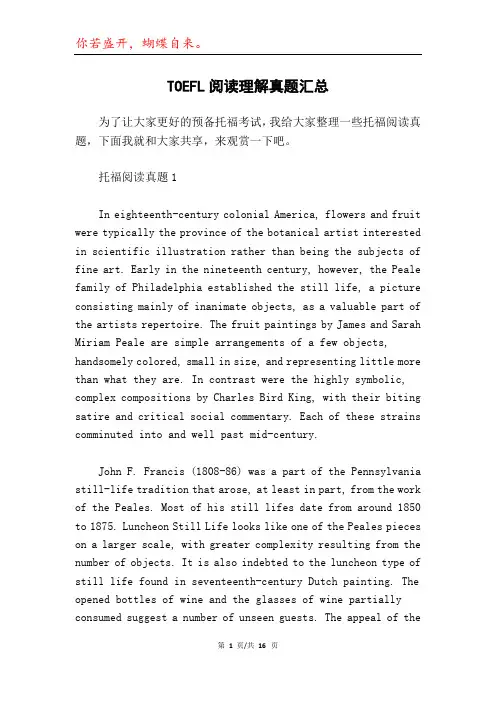
TOEFL阅读理解真题汇总为了让大家更好的预备托福考试,我给大家整理一些托福阅读真题,下面我就和大家共享,来观赏一下吧。
托福阅读真题1In eighteenth-century colonial America, flowers and fruit were typically the province of the botanical artist interested in scientific illustration rather than being the subjects of fine art. Early in the nineteenth century, however, the Peale family of Philadelphia established the still life, a picture consisting mainly of inanimate objects, as a valuable part of the artists repertoire. The fruit paintings by James and Sarah Miriam Peale are simple arrangements of a few objects, handsomely colored, small in size, and representing little more than what they are. In contrast were the highly symbolic, complex compositions by Charles Bird King, with their biting satire and critical social commentary. Each of these strains comminuted into and well past mid-century.John F. Francis (1808-86) was a part of the Pennsylvania still-life tradition that arose, at least in part, from the work of the Peales. Most of his still lifes date from around 1850 to 1875. Luncheon Still Life looks like one of the Peales pieces on a larger scale, with greater complexity resulting from the number of objects. It is also indebted to the luncheon type of still life found in seventeenth-century Dutch painting. The opened bottles of wine and the glasses of wine partially consumed suggest a number of unseen guests. The appeal of thefruit and nuts to our sense of taste is heightened by the juicy orange, which has already been sliced. The arrangement is additive, that is, made up of many different parts, not always compositionally integrated, with all objects of essentially equal importance.About 1848, Severin Roesen came to the United States from Germany and settled in New York City, where he began to paint large, lush still lifes of flowers, fruit, or both, often measuring over four feet across. Still Life with fruit and champagne is typical in its brilliance of color, meticulous rendering of detail, compact composition, and unabashed abundance. Rich in symbolic overtones, the beautifully painted objects carry additional meanings —butterflies or fallen buds suggest the impermanence of life, a birds nest with eggs means fertility, and so on. Above all, Roesens art expresses the abundance that America symbolized to many of its citizens.1. What does the passage mainly discuss?(A) The artwork of James and Sarah Miriam Peale(B) How Philadelphia became a center for art in the nineteenth century(C) Nineteenth-century still-life paintings in the United States(D) How botanical art inspired the first still-life paintings2. Which of the following is mentioned as a characteristic of the still lifes of James and SarahMiriam Peale?(A) simplicity(B) symbolism(C) smooth texture(D) social commentary3. The word biting in line 8 is closest in meaning to(A) simple(B) sorrowful(C) frequent(D) sharp4. The word It in line 13 refers to(A) Luncheon Still Life(B) one of the Peales pieces(C) a larger scale(D) the number of objects5. The word heightened in line 16 is closest in meaning to(A) complicated(B) directed(C) observed(D) increased6. The word meticulous in line 23 is closest in meaning to(A) careful(B) significant(C) appropriate(D) believable7. Which of the following terms is defined in the passage ?(A) repertoire (line 5)(B) satire (line 8)(C) additive (line 17)(D) rendering (line 23)8. All of the following are mentioned as characteristics of Roesens still lifes EXCEPT that they(A) are symbolic(B) use simplified representations of flowers and fruit(C) include brilliant colors(D) are large in size9. Which of the following is mentioned as the dominant theme in Roesens painting?(A) Fertility(B) Freedom(C) Impermanence(D) AbundancePASSAGE 89 CADAD ACBD托福阅读真题2Perhaps one of the most dramatic and important changes that took place in the Mesozoic era occurred late in that era, among the small organisms that populate the uppermost, sunlit portion of the oceans —the plankton. The term plankton is a broad one,designating all of the small plants and animals that float about or weakly propel themselves through the sea. In the late stages of the Mesozoic era, during the Cretaceous period, there was a great expansion of plankton that precipitated skeletons or shells composed of two types of mineral: silica and calcium carbonate.This development radically changed the types of sediments that accumulated on the seafloor, because, while the organic parts of the plankton decayed after the organisms died, their mineralized skeletons often survived and sank to the bottom. For the first time in the Earths long history, very large quantities of silica skeletons, which would eventually harden into rock, began to pile up in parts of the deep sea. Thick deposits of calcareous ooze made up of the tiny remains of the calcium carbonate-secreting plankton also accumulated as never before. The famous white chalk cliffs of Dover, in the southeast of England, are just one example of the huge quantities of such material that amassed during the Cretaceous period; there are many more. Just why the calcareous plankton were so prolific during the latter part of the Cretaceous period is not fully understood. Such massive amounts of chalky sediments have never since been deposited over a comparable period of time.The high biological productivity of the Cretaceous oceans also led to ideal conditions for oil accumulation. Oil is formed when organic material trapped in sediments is slowly buried and subjected to increased temperatures and pressures, transforming it into petroleum. Sediments rich in organic material accumulated along the margins of the Tethys Seaway, the tropical east-west ocean that formed when Earths singlelandmass (known as Pangaea) split apart during the Mesozoic era. Many of todays important oil fields are found in those sediments — in Russia, the Middle East, the Gulf of Mexico, and in the states of Texas and Louisiana in the United States.1. What does the passage mainly discuss?(A) How sediments were built up in oceans during the Cretaceous period(B) How petroleum was formed in the Mesozoic era(C) The impact of changes in oceanic animal and plant life in the Mesozoic era(D) The differences between plankton found in the present era and Cretaceous plankton2. The passage indicates that the Cretaceous period occurred(A) in the early part of the Mesozoic era(B) in the middle part of the Mesozoic era(C) in the later part of the Mesozoic era(D) after the Mesozoic era3. The passage mentions all of the following aspects of plankton EXCEPT(A) the length of their lives(B) the level of the ocean at which they are found(C) their movement(D) their size4. The word accumulated in line 8 is closest in meaning to(A) depended(B) matured(C) dissolved(D) collected5. According to the passage , the most dramatic change to the oceans caused by plankton duringthe Cretaceous period concerned(A) the depth of the water(B) the makeup of the sediment on the ocean floor(C) the decrease in petroleum-producing sediment(D) a decline in the quantity of calcareous ooze on theseafloor6. The white chalk cliffs of Dover are mentioned in line 14 of the passage to(A) show where the plankton sediment first began to build up(B) provide an example of a plankton buildup that scientists cannot explain(C) provide an example of the buildup of plankton sediment(D) indicate the largest single plankton buildup on Earth7. The word prolific in line 17 is closest in meaning to(A) fruitful(B) distinct(C) determined(D) energetic8. The word ideal in line 20 is closest in meaning to(A) common(B) clear(C) perfect(D) immediate9. The word it in line 22 refers to(A) biological productivity(B) oil(C) organic material(D) petroleumPASSAGE 90 CCADB CACC托福阅读真题3The term art deco has come to encompass three distinct but related design trends of the 1920s and 1930s. The first was what is frequently referred to as zigzag moderne — the exotically ornamental style of such skyscrapers as the Chrysler Building in New York City and related structures such as the Paramount Theater in Oakland, California. The word zigzag alludes to the geometric and stylized ornamentation of zigzags, angular patterns, abstracted plant and animal motifs, sunbursts, astrological imagery, formalized fountains, and related themes that were applied in mosaic relief, and mural form to the exterior and interior of the buildings. Many of these buildings were shaped in the ziggurat form, a design resembling an ancient Mesopotamian temple tower that recedes in progressivelysmaller stages to the summit, creating a staircase-like effect. The second manifestation of art deco was the 1930s streamlined moderne style — a Futuristic-looking aerodynamic style of rounded corners and horizontal bands known as speed stripes. In architecture, these elements were frequently accompanied by round windows, extensive use of glass block, and flat rooftops.The third style, referred to as either international stripped classicism, or simply classical moderne, also came to the forefront during the Depression, a period of severe economic difficult in the 1930s. This was a more conservative style, blending a simplified modernistic style with a more austere form of geometric and stylized relief sculpture and other ornament, including interior murals. Many buildings in this style were erected nationwide through government programs during the Depression.Although art deco in its many forms was largely perceived as thoroughly modern, it was strongly influenced by the decorative arts movements that immediately preceded it. For example, like art nouveau (1890-1910), art deco also used plant motifs, but regularized the forms into abstracted repetitive patterns rather than presenting them as flowing, asymmetrical foliage, like the Viennese craftspeople of the Wiener Werkstatte, art deco designers worked with exotic materials, geometricized shapes, and colorfully ornate patterns. Furthermore, like the artisans of the Arts and Crafts Movement in England and the United States, art deco practitioners considered it their mission to transform the domestic environment through well-designed furniture and household accessories.1. What aspect of art deco does the passage mainly discuss?(A) The influence of art deco on the design of furniture and household accessories(B) Ways in which government programs encouraged the development of art deco(C) Architectural manifestations of art deco during the 1920s and 1930s(D) Reasons for the popularity of art deco in New York and California2. The word encompass in line 1 is closest in meaning to(A) separate(B) include(C) replace(D) enhance3. The phrase The first in line 2 refers to(A) the term art deco(B) design trends(C) the 1920s and 1930s(D) skyscrapers4. In line 9, the author mentions an ancient Mesopotamian temple tower in order to(A) describe the exterior shape of certain art deco buildings(B) explain the differences between ancient and modern architectural steles(C) emphasize the extent of architectural advances(D) argue for a return to more traditional architectural design5. The streamlined moderne style is characterized by all of the following EXCEPT(A) animal motifs(B) flat roofs(C) round windows(D) speed stripes6. The phrase came to the forefront in line 16 is closest in meaning to(A) grew in complexity(B) went through a process(C) changed its approach(D) became important7. According to the passage , which of the following statements most accurately describes therelationship between art deco and art nouveau?(A) They were art forms that competed with each other for government support during theDepression era.(B) They were essentially the same art form.(C) Art nouveau preceded art deco and influenced it.(D) Art deco became important in the United States while art nouveau became popular inEngland.8. According to the passage , a building having an especially ornate appearance would mostprobably have been designed in the style of(A) zigzag moderne(B) streamlined moderne(C) classical moderne(D) the Arts and Crafts Movement9. According to the passage , which of the following design trends is known by more than onename?(A) Zigzag moderne(B) Streamlined moderne(C) International stripped classicism(D) Arts and Crafts Movement10. The passage is primarily developed as(A) the historical chronology of a movement(B) a description of specific buildings that became famous for their unusual beauty(C) an analysis of various trends within an artisticmovement(D) an argument of the advantages of one artistic form over anotherPASSAGE 91 CBBAA DCACC文档内容到此结束,欢迎大家下载、修改、丰富并分享给更多有需要的人。
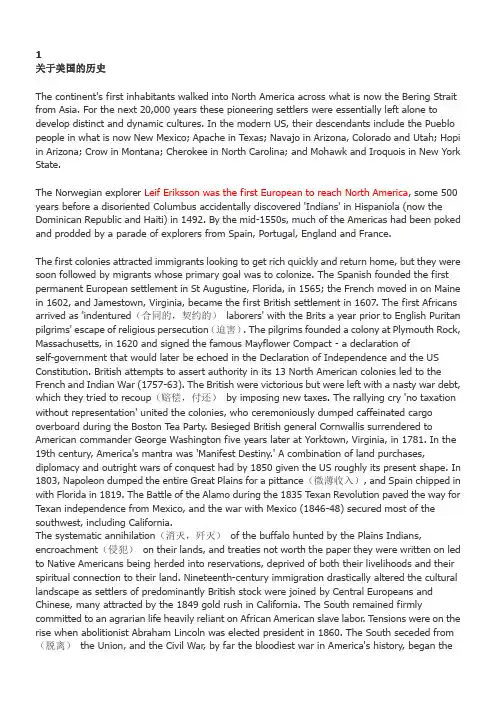
1关于美国的历史The continent's first inhabitants walked into North America across what is now the Bering Strait from Asia. For the next 20,000 years these pioneering settlers were essentially left alone to develop distinct and dynamic cultures. In the modern US, their descendants include the Pueblo people in what is now New Mexico; Apache in Texas; Navajo in Arizona, Colorado and Utah; Hopi in Arizona; Crow in Montana; Cherokee in North Carolina; and Mohawk and Iroquois in New York State.The Norwegian explorer Leif Eriksson was the first European to reach North America, some 500 years before a disoriented Columbus accidentally discovered 'Indians' in Hispaniola (now the Dominican Republic and Haiti) in 1492. By the mid-1550s, much of the Americas had been poked and prodded by a parade of explorers from Spain, Portugal, England and France.The first colonies attracted immigrants looking to get rich quickly and return home, but they were soon followed by migrants whose primary goal was to colonize. The Spanish founded the first permanent European settlement in St Augustine, Florida, in 1565; the French moved in on Maine in 1602, and Jamestown, Virginia, became the first British settlement in 1607. The first Africans arrived as 'indentured(合同的,契约的)laborers' with the Brits a year prior to English Puritan pilgrims' escape of religious persecution(迫害). The pilgrims founded a colony at Plymouth Rock, Massachusetts, in 1620 and signed the famous Mayflower Compact - a declaration ofself-government that would later be echoed in the Declaration of Independence and the US Constitution. British attempts to assert authority in its 13 North American colonies led to the French and Indian War (1757-63). The British were victorious but were left with a nasty war debt, which they tried to recoup(赔偿,付还)by imposing new taxes. The rallying cry 'no taxation without representation' united the colonies, who ceremoniously dumped caffeinated cargo overboard during the Boston Tea Party. Besieged British general Cornwallis surrendered to American commander George Washington five years later at Yorktown, Virginia, in 1781. In the 19th century, America's mantra was 'Manifest Destiny.' A combination of land purchases, diplomacy and outright wars of conquest had by 1850 given the US roughly its present shape. In 1803, Napoleon dumped the entire Great Plains for a pittance(微薄收入), and Spain chipped in with Florida in 1819. The Battle of the Alamo during the 1835 Texan Revolution paved the way for Texan independence from Mexico, and the war with Mexico (1846-48) secured most of the southwest, including California.The systematic annihilation(消灭,歼灭)of the buffalo hunted by the Plains Indians, encroachment(侵犯)on their lands, and treaties not worth the paper they were written on led to Native Americans being herded into reservations, deprived of both their livelihoods and their spiritual connection to their land. Nineteenth-century immigration drastically altered the cultural landscape as settlers of predominantly British stock were joined by Central Europeans and Chinese, many attracted by the 1849 gold rush in California. The South remained firmly committed to an agrarian life heavily reliant on African American slave labor. Tensions were on the rise when abolitionist Abraham Lincoln was elected president in 1860. The South seceded from (脱离)the Union, and the Civil War, by far the bloodiest war in America's history, began thefollowing year. The North prevailed(胜利)in 1865, freed the slaves and introduced universal adult male suffrage(选举权). Lincoln's vision for reconstruction, however, died with his assassination. America's trouncing of the Spaniards in 1898 marked the USA's ascendancy as a superpower and woke the country out of its isolationist slumber.The US still did its best not to get its feet dirty in WWI's trenches, but finally capitulated(停止抵抗,有条件投降)in 1917, sending over a million troops to help sort out the pesky(讨厌的,棘手的)Germans. Postwar celebrations were cut short by Prohibition in 1920, which banned alcohol in the country. The 1929 stock-market crash signaled the start of the Great Depression and eventually brought about Franklin Roosevelt's New Deal, which sought to lift the country back to prosperity. After the Japanese dropped in uninvited on Pearl Harbor in 1941, the US played a major role in defeating the Axis powers. Atomic bombs dropped on Hiroshima and Nagasaki in 1945 not only ended the war with Japan, but ushered in the nuclear age. The end of WWII segued into the Cold War - a period of great domestic prosperity and a surface uniformity belied by paranoia and betrayal. Politicians like Senator Joe McCarthy took advantage of the climate to fan anticommunist flames, while the USSR and USA stockpiled nuclear weapons and fought wars by proxy in Korea, Africa and Southeast Asia. Tensions between the two countries reached their peak in 1962 during the Cuban Missile Crisis.The 1960s was a decade of profound social change, thanks largely to the Civil Rights movement, Vietnam War protests and the discovery of sex, drugs and rock & roll. The Civil Rights movement gained momentum in 1955 with a bus boycott in Montgomery, Alabama. As a nonviolent mass protest movement, it aimed at breaking down segregation and regaining the vote for disfranchised Southern blacks. The movement peaked in 1963 with Martin Luther King Jr's 'I have a dream speech' in Washington, DC, and the passage of the landmark 1964 Civil Rights Act and 1965 Voting Rights Act. Meanwhile, America's youth were rejecting the conformity of the previous decade, growing their hair long and smoking lots of dope. 'Tune in, turn on, drop out' was the mantra of a generation who protested heavily (and not disinterestedly) against the war in Vietnam. Assassinations of prominent political leaders - John and Robert Kennedy, Malcolm X and Martin Luther King Jr - took a little gloss off the party, and the American troops mired in Vietnam took off the rest. NASA's moon landing in 1969 did little to restore national pride. In 1974 Richard Nixon became the first US president to resign from office, due to his involvement in the cover-up of the Watergate burglaries, bringing American patriotism to a new low.The 1970s and '80s were a period of technological advancement and declining industrialism. Self image took a battering at the hands of Iranian Ayatollah Khomeni. A conservative backlash, symbolized by the election and popular two-term presidency of actor Ronald Reagan, sought to put some backbone in the country. The US then concentrated on bullying its poor neighbors in Central America and the Caribbean, meddling in the affairs of El Salvador, Nicaragua, Panama and Grenada. The collapse of the Soviet Bloc's 'Evil Empire' in 1991 left the US as the world's sole superpower, and the Gulf War in 1992 gave George Bush the opportunity to lead a coalition supposedly representing a 'new world order' into battle against Iraq. Domestic matters, such as health reform, gun ownership, drugs, racial tension, gay rights, balancing the budget, the tenacious Whitewater scandal and the Monica Lewinsky 'Fornigate' affair tended to overshadow international concerns during the Clinton administration. In a bid to kickstart its then-ailing economy, the USA signed NAFTA, a free-trade agreement with Canada and Mexico, in 1993, invaded Haiti in its role of upholder of democracy in 1994, committed thousands of troops topeacekeeping operations in Bosnia in 1995, hosted the Olympics in 1996 and enjoyed, over the past few years, the fruits of a bull market on Wall St. The 2000 presidential election made history by being the most highly contested race in the nation's history.The Democratic candidate, Al Gore, secured the majority of the popular vote but lost the election when all of Florida's electoral college votes went to George W Bush, who was ahead of Gore in that state by only 500 votes. Demands for recounts, a ruling by the Florida Supreme Court in favor of partial recounts, and a handful of lawsuits generated by both parties were brought to a halt when the US Supreme Court split along party lines and ruled that all recounts should cease. After five tumultuous weeks, Bush was declared the winner. The early part of Bush's presidency saw the US face international tension, with renewed violence in the Middle East, a spy-plane standoff with China and nearly global disapproval of US foreign policy with regard to the environment. On the domestic front, a considerably weakened economy provided challenges for national policymakers. Whether the US can continue to hold onto its dominant position on the world stage and rejuvenate its economy remains to be seen.2英属北美殖民地的建立(1607--1733)北美洲原始居民为印第安人。
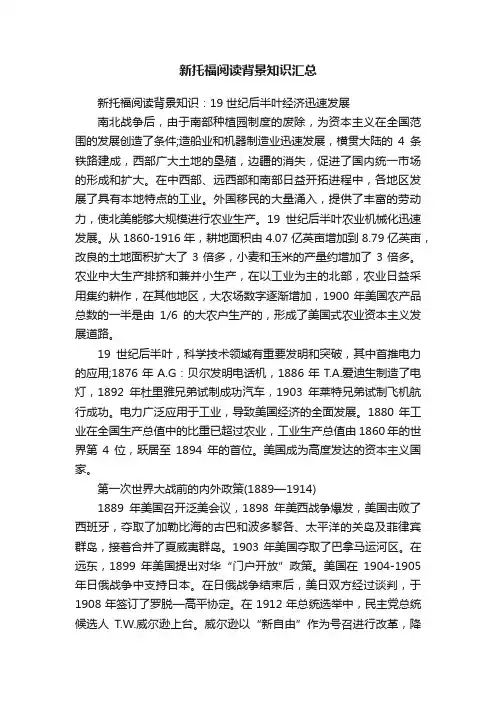
新托福阅读背景知识汇总新托福阅读背景知识:19世纪后半叶经济迅速发展南北战争后,由于南部种植园制度的废除,为资本主义在全国范围的发展创造了条件;造船业和机器制造业迅速发展,横贯大陆的4条铁路建成,西部广大土地的垦殖,边疆的消失,促进了国内统一市场的形成和扩大。
在中西部、远西部和南部日益开拓进程中,各地区发展了具有本地特点的工业。
外国移民的大量涌入,提供了丰富的劳动力,使北美能够大规模进行农业生产。
19世纪后半叶农业机械化迅速发展。
从1860-1916年,耕地面积由4.07亿英亩增加到8.79亿英亩,改良的土地面积扩大了3倍多,小麦和玉米的产量约增加了3倍多。
农业中大生产排挤和兼并小生产,在以工业为主的北部,农业日益采用集约耕作,在其他地区,大农场数字逐渐增加,1900年美国农产品总数的一半是由1/6的大农户生产的,形成了美国式农业资本主义发展道路。
19世纪后半叶,科学技术领域有重要发明和突破,其中首推电力的应用;1876年A.G:贝尔发明电话机,1886年T.A.爱迪生制造了电灯,1892年杜里雅兄弟试制成功汽车,1903年莱特兄弟试制飞机航行成功。
电力广泛应用于工业,导致美国经济的全面发展。
1880年工业在全国生产总值中的比重已超过农业,工业生产总值由1860年的世界第4位,跃居至1894年的首位。
美国成为高度发达的资本主义国家。
第一次世界大战前的内外政策(1889—1914)1889年美国召开泛美会议,1898年美西战争爆发,美国击败了西班牙,夺取了加勒比海的古巴和波多黎各、太平洋的关岛及菲律宾群岛,接着合并了夏威夷群岛。
1903年美国夺取了巴拿马运河区。
在远东,1899年美国提出对华“门户开放”政策。
美国在1904-1905年日俄战争中支持日本。
在日俄战争结束后,美日双方经过谈判,于1908年签订了罗脱—高平协定。
在1912年总统选举中,民主党总统候选人T.W.威尔逊上台。
威尔逊以“新自由”作为号召进行改革,降低关税,建立联邦储备银行制度,通过克莱顿反托拉斯法(1914),征收累进所得税。
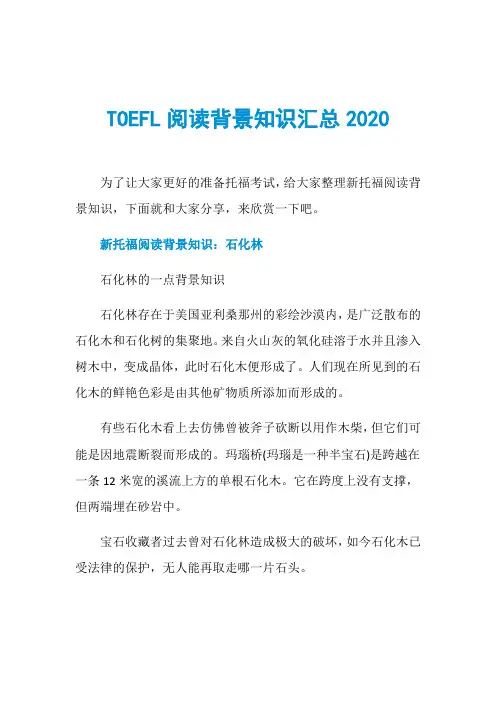
TOEFL阅读背景知识汇总2020为了让大家更好的准备托福考试,给大家整理新托福阅读背景知识,下面就和大家分享,来欣赏一下吧。
新托福阅读背景知识:石化林石化林的一点背景知识石化林存在于美国亚利桑那州的彩绘沙漠内,是广泛散布的石化木和石化树的集聚地。
来自火山灰的氧化硅溶于水并且渗入树木中,变成晶体,此时石化木便形成了。
人们现在所见到的石化木的鲜艳色彩是由其他矿物质所添加而形成的。
有些石化木看上去仿佛曾被斧子砍断以用作木柴,但它们可能是因地震断裂而形成的。
玛瑙桥(玛瑙是一种半宝石)是跨越在一条12米宽的溪流上方的单根石化木。
它在跨度上没有支撑,但两端埋在砂岩中。
宝石收藏者过去曾对石化林造成极大的破坏,如今石化木已受法律的保护,无人能再取走哪一片石头。
土著美洲人有一个解释石化林如何产生的故事。
一位女神为生火做饭集木头,但木头很湿不能燃烧。
女神很生气,便对一些木头施以恶咒语,把这们变成了石头,不能再为任何人所使用。
新托福阅读背景知识:初识芭蕾初识芭蕾芭蕾(Ballet)一词,源自意大利文Ballard,意思就是跳舞,专指“足尖舞”,是欧洲古典舞蹈的一种形式。
在其发展过程中,因常以这种舞蹈来叙述表演故事,而逐渐形成了一种特殊的演出形式。
1772年,查理·狄德罗(Charles Diderot)在法国大百科全书中说:“芭蕾系用跳舞解释行动……特别要求剧场性的赏心悦目……”。
帕鲁金尼(Perugino)更详细地叙述说:“芭蕾是由一位编导,运用连带哑剧的一系列独舞和群众,附加音乐和布景,去表现一种诗情画意,或一连串概念,或一个故事化的情节。
”芭蕾这种舞蹈形式一直发展到今天,形成了完整的舞剧艺术。
对于中国观众来说,芭蕾并不陌生,尤其近些年来,芭蕾受到了越来越多的观注,一股“芭蕾热”已经在几座大城市悄然兴起。
1997年的“中国歌剧舞剧年”可以说是热闹非凡,各个中外演出团体为广大观众献上了一台又一台精彩的演出,真是“你方唱罢我登场”。
新托福加试(听力/阅读)大全——内含答案及背景浪漫主义诗歌机经原文:本文讲18-19世纪英国浪漫主义诗歌的特点。
威廉·华兹华斯(William Wordsworth)是浪漫主义诗歌的鼻祖。
但是,开始时,他们并没有称这种诗歌形式为浪漫主义,浪漫主义诗人这个称谓是他们的后人为他们加上的。
浪漫主义中的浪漫并不是我们平时所理解的“浪漫”,这里的“浪漫”与男女之间的爱情无关。
浪漫主义诗歌针对的是普通大众,而不是少数受过教育的人。
浪漫主义诗歌用的是简单语言,描述的是日常生活中常见的事物,比如孩子、人与人之间的情感、以及自然和人类之间的互动。
教授说,我自己在散步时感受到了这种所谓的自然与人类之间的互动。
与浪漫主义针锋相对的一种风格是新古典主义(neo-classicism),浪漫主义的鼻祖——威廉·华兹华斯很反对新古典主义。
新古典主义诗歌中使用了太多的详尽细节(elaboration)。
比如,在新古典主义诗歌中:天空(sky)不叫天空,而是叫了蓝色(blue);鸟(bird)不叫鸟,而叫羽人(feathered person)。
威廉·华兹华斯的作品分为3个阶段。
1.早期的浪漫主义作品,主要描述植物的(花与草)诗歌。
2.中期的浪漫主义作品,主要是对一些社会现象的评论。
3.后期的浪漫主义作品,主要是对早期的作品进行修改。
目前文学界还是认为他早期的作品是最好的。
教授认为他的诗越写到后来就越糟糕,反而早期的比较好。
但是在课堂上,我就不对中厚期的作品作评价了。
真题重现:(1)问:浪漫主义诗人的称谓是怎么来的?答:浪漫主义诗人这个称谓是后人为他们加上的,不是他们本身这样称呼自己的。
(2)问:演讲中为何提到了教授散步?答:为了说明自然与人类之间的互动。
(3)问:(双选)浪漫主义诗的特点是什么?答:1.针对的是个人情感;2.与古典主义不同。
(4)问:(重听题)教授说“在课堂上,我就不对中厚期的作品作评价了”暗示了什么?答:演讲中重点介绍威廉·华兹华斯的早期作品。
托福阅读生物类背景知识及真题珊瑚礁珊瑚礁(coral reef)是指造礁石珊瑚群体死后其遗骸(remains)构成的岩体。
珊瑚礁的主体是由珊瑚虫(polyp)组成的。
珊瑚虫是海洋中的一种腔肠动物在生长过程中能吸收海水中的钙和二氧化碳,然后分泌出石灰石(limestone),变为自己生存的外壳。
每一个单体的珊瑚虫只有米粒那样大小,它们一群一群地聚居在一起,一代代地新陈代谢(metabolism),生长繁衍,同时不断分泌出石灰石,并粘合在一起。
这些石灰石经过以后的压实、石化,形成岛屿和礁石,也就是所谓的珊瑚礁(coral reef)。
达尔文根据礁体与岸线的关系,划分出岸礁(fringing reef)、堡礁(barrier reef)和环礁(atoll)。
fringing reef暗礁沿大陆(mainland)或岛屿(island)岸边(shore)生长发育,亦称裙礁或边缘礁。
现代最长的岸礁沿红海沿岸发育,绵延约2700多公里,分布水深约36米。
中国台湾恒春半岛和海南岛沿岸也有岸礁发育。
barrier reef堡礁又称堤礁,是离岸有一定距离的堤状礁体,它与陆地隔以泻湖(环礁湖)(lagoon)。
现代规模最大的堡礁是澳大利亚昆士兰大堡礁,全长约2000公里,分布水深约30米。
atoll环礁礁体呈环带状围绕泻湖(lagoon),有的与外海有水道相通。
环礁直径在几百米至几十公里,形态多样。
已知的环礁有330个之多,主要分布在西太平洋的信风带和印度洋热带海域。
环礁多坐落在大洋火山锥上,孤立于汪洋大海之中,展布受洋底火山(volcano)作用的控制,某些也可在大陆架(continental shelf)上见到。
环礁礁坪上常有灰砂(砾)岛或礁岩岛,统称为珊瑚岛。
马绍尔群岛上的夸贾林环礁和马尔代夫群岛的苏瓦迪瓦环礁,面积都在1800平方公里以上,是世界上最大的两个环礁。
南海发育的环礁颇具特色,有泻湖全被封闭的玉琢礁;有泻湖与外海有3个通道的华光礁;还有多通道开放式的永乐环礁,半月形全开放式的宣德环礁。
tpo50三篇托福阅读TOEFL原文译文题目答案背景知识阅读-1 (2)原文 (2)译文 (5)题目 (7)答案 (16)背景知识 (18)阅读-2 (21)原文 (21)译文 (24)题目 (27)答案 (35)背景知识 (37)阅读-3 (41)原文 (41)译文 (44)题目 (47)答案 (54)背景知识 (55)阅读-1原文American Railroads①In the United States,railroads spearheaded the second phase of the transportation revolution by overtaking the previous importance of canals.The mid-1800s saw a great expansion of American railroads. The major cities east of the Mississippi River were linked by a spiderweb of railroad tracks.Chicago's growth illustrates the impact of these rail links.In1849Chicago was a village of a few hundred people with virtually no rail service.By1860it had become a city of100,000, served by eleven railroads.Farmers to the north and west of Chicago no longer had to ship their grain,livestock,and dairy products down the Mississippi River to New Orleans;they could now ship their products directly east.Chicago supplanted New Orleans as the interior of America's main commercial hub.②The east-west rail lines stimulated the settlement and agricultural development of the Midwest.By1860Illinois,Indiana,and Wisconsin had replaced Ohio,Pennsylvania,and New York as the leading wheat-growing states.Enabling farmers to speed their products to the East,railroads increased the value of farmland and promotedadditional settlement.In turn,population growth in agricultural areas triggered industrial development in cities such as Chicago,Davenport (Iowa),and Minneapolis,for the new settlers needed lumber for fences and houses and mills to grind wheat into flour.③Railroads also propelled the growth of small towns along their routes.The Illinois Central Railroad,which had more track than any other railroad in1855,made money not only from its traffic but also from real estate speculation.Purchasing land for stations along its path, the Illinois Central then laid out towns around the stations.The selection of Manteno,Illinois,as a stop of the Illinois Central,for example,transformed the site from a crossroads without a single house in1854into a bustling town of nearly a thousand in1860, replete with hotels,lumberyards,grain elevators,and gristmills.By the Civil War(1861-1865),few thought of the railroad-linked Midwest as a frontier region or viewed its inhabitants as pioneers.④As the nation's first big business,the railroads transformed the conduct of business.During the early1830s,railroads,like canals, depended on financial aid from state governments.With the onset of economic depression in the late1830s,however,state governments scrapped overly ambitious railroad projects.Convinced that railroads burdened them with high taxes and blasted hopes,voters turnedagainst state aid,and in the early1840s,several states amended their constitutions to bar state funding for railroads and canals.The federal government took up some of the slack,but federal aid did not provide a major stimulus to railroads before1860.Rather,part of the burden of finance passed to city and county governments in agricultural areas that wanted to attract railroads.Such municipal governments,for example,often gave railroads rights-of-way,grants of land for stations, and public funds.⑤The dramatic expansion of the railroad network in the1850s, however,strained the financing capacity of local governments and required a turn toward private investment,which had never been absent from the picture.Well aware of the economic benefits of railroads,individuals living near them had long purchased railroad stock issued by governments and had directly bought stock in railroads, often paying by contributing their labor to building the railroads.But the large railroads of the1850s needed more capital than such small investors could generate.Gradually,the center of railroad financing shifted to New York City,and in fact,it was the railroad boom of the 1850s that helped make Wall Street in New York City the nation's greatest capital market.The stocks of all the leading railroads were traded on the floor of the New York Stock Exchange during the1850s. In addition,the growth of railroads turned New York City into thecenter of modern investment firms.The investment firms evaluated the stock of railroads in the smaller American cities and then found purchasers for these stocks in New York City,Philadelphia,Paris, London,Amsterdam,and Hamburg.Controlling the flow of funds to railroads,the investment bankers began to exert influence over the railroads'internal affairs by supervising administrative reorganizations in times of trouble.译文美国铁路①在美国,铁路超越了运河从前的重要性,成为运输革命第二阶段的先锋。
TOEFL阅读背景知识为了让大家更好的准备托福考试,给大家整理新托福阅读背景知识,下面就和大家分享,来欣赏一下吧。
新托福阅读背景知识:地球的旋转时间变短地球的旋转时间变短We have been talking about some of the effects that the human beings had on the earth. One you may not be aware of is that we actually begin to change the length of the day. In the other way to say, one day is the amount of time the earth needs to spin completely around an axis, the imaginary line around the center of the earth, from the north to the south. And of course there are a lot of physical causes th at can affect the speed of the earth’s rotation, but there was only one that is direct result of the human activity. Since 1950, human beings have built about ten thousand artificial reservoirs all over the world. These reservoirs have redistributed tremendous amount of the earth water. When they are used to be in the area near the equator, the imaginary line surround the middle of the earth, it’s now the reservoirs in the areas of differentlatitudes. The latitude matters because, well, thinking the earth and axis, the equator contains the areas on the earth that are the farthest away from axis. So water has been redistributed from the equator regions, then wherever the water is, to it’s close to the earth axis. It’s like when ice skaters perform spins when those skaters put their arms enclose to their bodies, they spin faster. So the earth is spinning faster because the reservoirs have redistributed the water close to its axis. And because the earth was spinning faster, since 1950 the length of day has decreased by about 8 millionths of second. I know that doesn’t sound like much but significant in that this is the first time that human beings ever had measurable affect on the earth’s motion.新托福阅读背景知识:潮汐发电潮汐发电凡在海边上生活过的人都知道,海水时进时退,海面时涨时落。
托福考试阅读背景知识(下)第二次世界大战后第二次世界大战规模空前。
战争中发生的事,如600万犹太人被屠杀,原子弹在广岛爆炸,使美国知识分子感到震惊。
他们怀疑人性是否还有善良的一面,也感到人难以控制自己制造出来的巨大物质力量。
他们对文明与进步的信念发生了极大动摇。
50年代在“冷战”、麦卡锡主义和朝鲜战争的背景下,文坛趋于沉寂;印、70年代,经过越南战争、民权运动、学生运动、女权运动、水门案件,文坛活跃起来,出现了一批爱思索的作家。
在他们眼里,美国的社会变得十分复杂,价值观念混乱。
他们普遍感到不知怎样解释这样的现实,于是便通过怪诞、幻想、夸张的方式,再现生活中的混乱、恐怖和疯狂。
他们表现的是没有目标与方向的梦境世界他们讲的是支离破碎的故事,写的是“反英雄”、甚至是不完整的形象。
这个时期,文学作品中对**(包括同性爱)的描写也更为;露骨。
战争文学战后出现的第一股文学浪潮是战争小说。
其中较好的是梅勒的《裸者和死者》(1948)和詹姆斯·琼斯的《从这里到永恒》(1951)。
两部书的共同点是通过战争,写小兵、下级军官与军事机构的矛盾,即人的个性与扼杀个性的权力机构之间的冲突。
这些小说已经触及战后整个一代文学最突出的一个主题。
“怯懦的十年”50年代,右翼保守势力向30年代激进主义传统进攻,许多人由关心社会进步转而关心个人的私利。
这10年被称为“怯懦的十年”或“沉寂的十年”。
这期间,出现了一些作品,将资产阶级描绘成正面人物,鼓吹服从权威,如《穿灰法兰绒衣服的人》(1955)。
这类作品企图维护既定价值标准和现存社会秩序,很快就失去了影响。
另一方面,阿瑟·米勒等作家抵制麦卡锡主义,继续用作品抨击社会的不正义。
“垮掉的一代”50年代沉闷的政治空气使许多青年感到窒息,他们吸毒、群居,以颓唐、放纵的生活方式来表示自己的抗议。
其中有些人把这种生活与情绪写入文学作品,这便是“垮掉的一代”文学。
这种文学发展到60年代后,在国内民主运动高涨的背景下,增加了一些政治色彩。
【TPO小站内部资料精选】托福阅读真题背景汇总托福阅读的关键是在于多看多练,同样一篇文章,如果熟悉其中背景,阅读起来就比较轻松,做题的速度和准确率也会提高不少。
下面,我将根据历年托福阅读真题,总结出一部分常见托福阅读背景,希望对大家有所帮助。
一、印第安题材1.白令海峡移民理论2.印第安文化3.印第安宗教观4.印第安建筑业:大、先进。
5.印第安手工业:好。
6.社会组织结构:严密、分工细、凝聚力强。
7.农业先进:A. irrigation; B. maize, squash, bean, pea。
二、动植物题材(必考)1.植物学题材(一般纯植物学不多)a. 地衣、苔、真菌、蘑菇最常见。
b. 树冠上方生物。
c. 植物在生态平衡中的作用(或作为平衡生态系统的手段)。
2.动物学题材(90%以上)a. 考普通动物为多。
最近常考鸟类、蚂蚁、动物智能与灭绝(联系天文学与冰河理论)。
b. 考动物进化(evolution)。
c. 考动物的分类(classification)。
phyla(单数phylum) —门 class—纲 order—目 family—科 genus—属species—种 carnivore/predator—食肉动物 herbivore—食草动物 omnivore —杂食动物d. 动物的生活习性最为多见。
1. 群居(social animal)动物的习性a) 蚂蚁:社会组织结构—等级制(hierarchy):交流方式—信息素—气味;生活来源;外来物种的有害性。
b) 蜜蜂:群居个性;圆舞(食物较近时)摇摆舞(waggle dance食物较远时);蜜蜂智能;防御;天敌—大黄蜂。
c) 大猩猩:智能:猩际关系2.迁徙 (migration)野鸭、大雁:日照长短;辨别方向。
3. 伪装 (camouflage)、花拟态(mimicry )三、考古学(archaeology)题材1.文化(cultural) 考古学形态(physical)考古学(多见)2.化石(fossil)a) 化石构成。
【TPO小站内部资料】托福阅读真题背景汇总
托福阅读的关键是在于多看多练,同样一篇文章,如果熟悉其中背景,阅读起来就比较轻松,做题的速度和准确率也会提高不少。
下面,我将根据历年托福阅读真题,总结出一部分常见托福阅读背景,希望对大家有所帮助。
一、印第安题材
1.白令海峡移民理论
2.印第安文化
3.印第安宗教观
4.印第安建筑业:大、先进。
5.印第安手工业:好。
6.社会组织结构:严密、分工细、凝聚力强。
7.农业先进:A. irrigation; B. maize, squash, bean, pea。
二、动植物题材(必考)
1.植物学题材(一般纯植物学不多)
a. 地衣、苔、真菌、蘑菇最常见。
b. 树冠上方生物。
c. 植物在生态平衡中的作用(或作为平衡生态系统的手段)。
2.动物学题材(90%以上)
a. 考普通动物为多。
最近常考鸟类、蚂蚁、动物智能与灭绝(联系天文学与冰河理论)。
b. 考动物进化(evolution)。
c. 考动物的分类(classification)。
phyla(单数phylum) —门 class—纲 order—目 family—科 genus—属species—种 carnivore/predator—食肉动物 herbivore—食草动物 omnivore —杂食动物
d. 动物的生活习性最为多见。
1. 群居(social animal)动物的习性
a) 蚂蚁:社会组织结构—等级制(hierarchy):交流方式—信息素—气味;生活来源;外来物种的有害性。
b) 蜜蜂:群居个性;圆舞(食物较近时)摇摆舞(waggle dance食物较远时);蜜蜂智能;防御;天敌—大黄蜂。
c) 大猩猩:智能:猩际关系
2.迁徙 (migration)
野鸭、大雁:日照长短;辨别方向。
3. 伪装 (camouflage)、花拟态(mimicry )
三、考古学(archaeology)题材
1.文化(cultural) 考古学
形态(physical)考古学(多见)
2.化石(fossil)
a) 化石构成。
化石比原物更沉重 (矿物质环境)
b) 化石形成原因。
坚硬物质,迅速掩埋。
c) 化石与动物的进化关系。
3.人的左右手
a) 使用工具。
证据:敲击的划痕;手柄的形状。
b) 牙齿上的划痕。
c) 大脑左右半球的大小差别;趾骨的粗细差别。
d) 作画时人像的方向
4.古代陶瓷的考古
Clay, model, wheel (转盘 ), glaze, kiln
5.古代文字的考古
四、艺术(Art)题材
1.绘画(painting)
a)分类:雕刻(engrave);岩洞艺术(cave art);油画等。
b)材料:颜料(pigment);蜡(wax);画布(canvas)。
c)画法:透视法(perspective)。
2.陶器(pottery)
3.建筑(architecture)
a)要素:空间;质量(mass);线条;纹理(texture);光线;色彩。
b)风格:现实(realistic);自然(naturalistic);印象派(impressionist ic)
4.摄影(photography)
5.音乐(music)
五、美国历史题材
1.美国发展线索
a) 发现美洲阶段
哥伦布(意),为黄金、茶叶、香料
West/East Indian
影响:世界观变化;国家形势变化;(爱尔兰——土豆饥荒 )
b) 英国定居阶段(English settlement )
1607第一个定居点Captain John S影响清教徒
1620五月花号
c) 殖民时期(colonial era)
d) 独立战争(American Revolution)
e) 新的国家(new nation) 南北不均衡
f) 南北战争(Civil War)
g) 战后重建。
持续近100年。
h) 西进运动 (Westward movement)人口迁移之类
i) 工业化大增长
j) world war I & II
End :1960
2.“大熔炉”:地理位置;民族融合1960’s;文化融合。
3.邮政。
快递和铁路邮政
综上所述,托福阅读考试范围非常之广,对知识面要求相对较高,如果能够适当补充相关背景知识,那么在考场上做题时也不会特别慌张和头疼了。
同时,能够了解各方面的知识也是托福考试的魅力所在,在复习过程中大家还能丰富各学科知识,何乐而不为!。